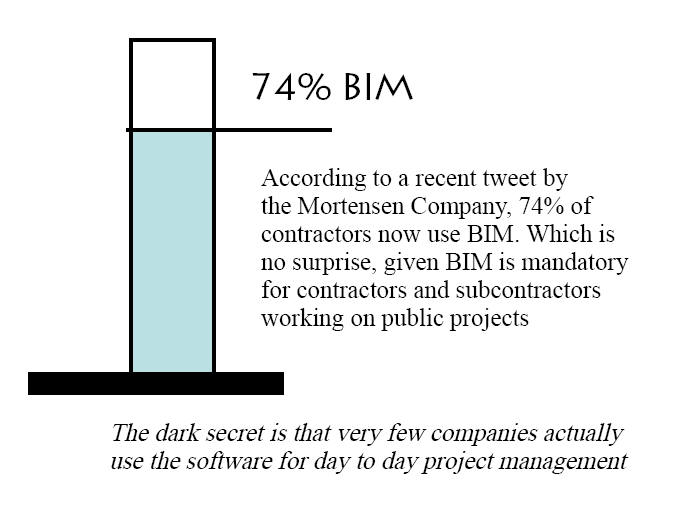2D Techs or Construction Managers
In fact, it took a new generation of project managers to introduce this simple technology to reluctant old-timers – and as most would admit, the fight goes on.
For example, now that cell phones and voice mail have become standards for project communications, some offices actually still take messages on hand written note pads, while senior managers without keyboard skills have assistants write memos and handle emails for them, finding computers intrusive, distracting, and perhaps a little frightening.

At the same time, according to a recent tweet from The Mortensen Company, more contractors now use BIM software than designers. Of course, it goes without saying that the average builder has no idea who Mortensen is, and though construction companies may claim to own some version of BIM software, complex 3D modeling is largely ignored for spreadsheets, print outs, and face to face fieldwork during actual construction. Even at Mortensen’s.
BIM in the Real World
It’s no secret then that BIM software requires trained technicians, anchored to software and graphic workstations that require constant updates and attention. In practice, working with this kind of technology is simply not practical on most jobsites, especially when a rolled out set of printed 2d contract documents are the basis for the actual scope of the work.

It’s also important to point out that design, including BIM and its 2D documents are only a very small part of the real world of construction management. Based on the value and cost of services, barely 10% of the entire process is design, permitting, and preconstruction, and of that, perhaps half of the effort falls into actual BIM production.
90% of Construction is Communications
Following the money, the focus should be on what is happening on the jobsite and finding ways to communicate more efficiently with the real world that surrounds it.

Especially considering that today, computer programs like SketchUp transfer files over the internet, send emails from menu selections, and automatically upload images, cost and schedule data, and daily reports to the cloud as a common way of storing, cataloging, and accessing construction information.
For a new generation of managers, communications between team members now occurs on PDAs (personal data assistants), immediately using smart phones to photo, scan, text, and tweet annotated images and video exported from SketchUp to coordinate project activities.
Mobility is the New Norm
The mobility of these new devices and their ability to access an unlimited combination of resources has become a fundamental part of a continuous and instantaneous flow of project communications.

All of which is broadcasted wirelessly via satellite, cells, or broadband routers, giving managers immediate access to project information, the web for searches and bookmarks, networking platforms like Linked In and Facebook for market and background information, and graphical tools like You-Tube, image reference libraries, and animations for process control.
Today, the challenge is to understand how to use these new technologies effectively for construction communications, waiting again for a new generation of builders to demonstrate their competitive value in the real world.
.
